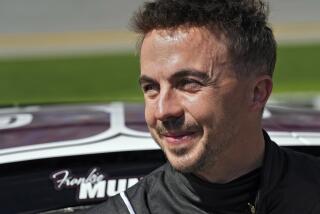Bob Forrest’s unlikely career arc

Jason Davis, a 25-year-old heroin addict and grandson of oil billionaire Marvin Davis, was the most shameless cast member on “Celebrity Rehab With Dr. Drew” last season, a distinction akin to being the nerdiest person at a “Star Trek” convention — the bar is so high, you really have to reach for it.
The show’s medical team, led by addictionologist Drew Pinsky, spent the season trying to impress on Davis the direness of his disease. Among the earnest pleas, one voice seemed to crack through Davis’ defenses.
“You come off as cavalier and fabulous, all Thurston Howell III, but you’re scared too,” said drug counselor Bob Forrest.
In his signature brown fedora and horn-rimmed glasses, with pocked skin and an acid wit, Forrest is the truth-teller on “Celebrity Rehab,” the show about D-list addicts currently in its fifth season on VH1. At 50, he is the rare character to emerge from a reality program who is not a caricature with camera-ready bleached teeth, but a three-dimensional person with a rich and complicated history.
Forrest’s textured story is told in the new documentary “Bob and the Monster,” which has its Los Angeles premiere Thursday as part of the Don’t Knock the Rock Film and Music Festival. The film traces his unlikely career arc from leader of the post-punk Los Angeles band Thelonious Monster in the 1980s to full-time Hollywood junkie in the 1990s to modern-day mouthpiece for addiction treatment.
“The thing that made Bob a great frontman was his ability to connect with the audience,” said “Bob and the Monster” director Keirda Bahruth. “He was always sharing. He’s just taken what was his nature then and turned it into another way to connect with people.”
Bahruth unspools Forrest’s story using interviews with his contemporaries, including Courtney Love and members of the Red Hot Chili Peppers and Guns N’ Roses, chaotic concert footage of his band and animation of some of Forrest’s key, unfilmed life moments, such as when he first shot heroin at age 19 and first met Pinsky in the 1980s.
“I was a lot of people’s lower companion. I was the drug procurer of the stars,” Forrest said in an interview at Hollywood Recovery Services, a kind of finishing school for drug addicts he founded, which occupies a few sunny rooms 11 stories above Hollywood Boulevard and Vine Street. “People thought, this poor, pathetic bastard. And then I’m the one that gets sober. I guess they could trust that … if Bob could do it, anyone can do it.”
Forrest grew up in Palm Springs, the youngest child of the builder of the giant T signs for the Thrifty drugstores and a housewife — or so he thought until age 13, when he learned that his sister was actually his mother. He attended community college before quitting to DJ and party full time. By 24, he was playing rock clubs and releasing his first record with Thelonious Monster. The band’s 1987 album, “Next Saturday Afternoon,” caught the attention of then-Los Angeles Times pop music critic Robert Hilburn.
“It was a mini-masterpiece, a series of questions about identity and self-worth,” said Hilburn. “I believed in that Bob Forrest. He was a raw jewel in the scene, but the question was, was he gonna destroy himself?”
At least temporarily, the answer was yes. A series of temper tantrums on stage and off alienated Forrest from his bandmates as he cycled between heroin, cocaine and alcohol and 24 stints in rehab. At various points in the cycle, he appeared as a guest on Pinsky’s radio show, “Loveline,” to promote his music.
“He was one of the worst drug addicts I’d ever been around,” said Pinsky. “He was manic and out of control. He was so unpleasant to be around, angry and disagreeable. Eventually I just wrote him off and frankly, I assumed he was dead.”
It was after a five-week jail stay in 1996 that Forrest got clean and embarked on a humble, sober life washing dishes at Millie’s Cafe in Silver Lake, attending 12-step meetings and being father to Elijah, the son he had largely neglected. Now 24, Elijah plays music and works in construction in Baltimore. Forrest also has a fiancée and a 9-month-old son named Elvis.
Forrest was attending a lecture on addiction in the late ‘90s when he reconnected with Pinsky, who ultimately brought him on to work with him as a counselor.
“Bob helps people who are unreachable,” Pinsky said. “He says these quirky, profound things. It’s based on his own experience.”
Forrest quickly established a reputation for being able to talk the most volatile addicts out of walking out of treatment — in hospital parlance, he was good at keeping “heads on beds.”
“I was laying in bed one night thinking, ‘Heads on beds, that’s so disgusting,’” Forrest said. “God, I went from [butts] in seats to heads on beds. That’s the story of my life.”
In 2007 — roughly around when Britney Spears was shaving her head in front of paparazzi after walking out of rehab — Forrest pressed Pinsky to get a TV show made about what they do. “I came into work one day and I was so angry,” Forrest said. “People were saying rehab is a joke. Rehab is a real thing. I’ve lived in it and worked in it for 20 years and … we need to fight back. Rehab needs to be on television cause America’s so dumb it needs to see it.”
By 2008, Pinsky and Forrest were on the air with their first class of addicts and the show quickly became a guilty-pleasure hit, spawning the spinoffs “Sober House” and “Sex Rehab With Dr. Drew.” Since then, the show has drawn criticism from others in the drug treatment world who say it exploits addicts. Forrest is conflicted about “Celebrity Rehab,” which he says depicts the reality of the deadly disease of addiction, but not always in the manner he had envisioned.
“If I had to do it all over again I don’t think I’d walk into the office and say we should do this show,” Forrest said of “Celebrity Rehab.” “I don’t like the editing of it. I don’t like that they show the same thing over and over again. I don’t like what it’s become technically.”
In 2010, Forrest founded Hollywood Recovery Services, where he counsels many of the cast members who appear on “Celebrity Rehab” after they leave rehab, as well as civilian addicts. He has a staff of four, including a psychiatrist.
Among Hollywood Recovery Services’ regulars is Jason Davis, who relapsed multiple times after the last season of “Celebrity Rehab” finished shooting.
“Out of all the counselors I had, Bob truly got me,” Davis said.
Davis says he is five months clean, and talks to Forrest almost every day.
More to Read
The biggest entertainment stories
Get our big stories about Hollywood, film, television, music, arts, culture and more right in your inbox as soon as they publish.
You may occasionally receive promotional content from the Los Angeles Times.







